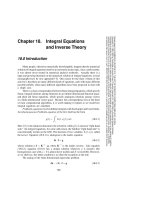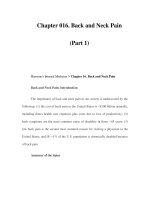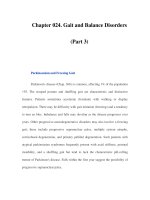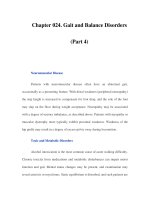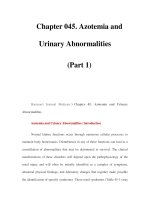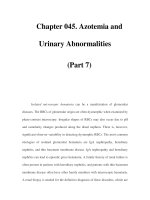Chapter 131. Diphtheria and Other Infections Caused by Corynebacteria and Related Species (Part 1) pptx
Bạn đang xem bản rút gọn của tài liệu. Xem và tải ngay bản đầy đủ của tài liệu tại đây (13.86 KB, 5 trang )
Chapter 131. Diphtheria and Other Infections Caused by
Corynebacteria and Related Species
(Part 1)
Harrison's Internal Medicine > Chapter 131. Diphtheria and Other
Infections Caused by Corynebacteria and Related Species
Diphtheria
Diphtheria is a nasopharyngeal and skin infection caused by
Corynebacterium diphtheriae. Toxigenic strains of C. diphtheriae produce a
protein toxin that causes systemic toxicity, myocarditis, and polyneuropathy. The
toxin is associated with the formation of pseudomembranes in the pharynx during
respiratory diphtheria. While toxigenic strains most frequently cause pharyngeal
diphtheria, nontoxigenic strains commonly cause cutaneous disease. In the United
States and Europe, diphtheria has been controlled in recent years with effective
vaccination, although sporadic outbreaks have occurred. Diphtheria is still
common in the Caribbean, Latin America, and the Indian subcontinent, where
mass immunization programs are not enforced. Large epidemics have occurred in
the independent states formerly encompassed by the Soviet Union. Additional
outbreaks have been reported in Algeria, China, and Ecuador.
Etiology
C. diphtheriae is a gram-positive, unencapsulated, nonmotile,
nonsporulating bacillus. C. diphtheriae organisms have a characteristic club-
shaped bacillary appearance and typically form clusters of parallel rays (palisades)
that are referred to as Chinese characters. In the specific laboratory media
recommended for the cultivation of C. diphtheriae, tellurite, colistin, or nalidixic
acid is responsible for selective isolation of the organism in the presence of other
autochthonous pharyngeal microbes. Human isolates of C. diphtheriae may
display nontoxigenic (tox
–
) or toxigenic (tox
+
) phenotypes. Corynebacteriophage
beta carries the structural gene (tox) encoding diphtheria toxin, and a family of
closely related corynebacteriophages are responsible for toxigenic conversion of
tox
–
C. diphtheriae to the tox
+
phenotype. Moreover, lysogenic conversion from a
nontoxigenic to a toxigenic phenotype has been shown to occur in situ. Growth of
toxigenic strains of C. diphtheriae under iron-limiting conditions leads to the
optimal expression of diphtheria toxin, and these conditions are believed to be a
mechanism of pathogenesis during human infection.
Epidemiology
C. diphtheriae is transmitted via the aerosol route, primarily during close
contact. There are no significant reservoirs other than humans. The incubation
period for respiratory diphtheria is 2–5 days; however, disease can develop as long
as 10 days after exposure. Before the vaccine era, most individuals over the age of
10 were immune to C. diphtheriae; infants were protected by maternal IgG
antibodies but became susceptible after ~6 months of age. Thus, the disease was
seen primarily in children and nonimmune young adults. In temperate regions,
respiratory diphtheria occurs year-round but is most common during winter
months.
The development of diphtheria antitoxin and diphtheria toxoid vaccine led
to the near-elimination of diphtheria in Western countries. The annual peak
incidence rate was 191 cases per 100,000 population in the United States in 1921;
in contrast, since 1980, the annual figure for the United States as a whole has been
<5 cases. Nevertheless, pockets of colonization have persisted in North America,
particularly in South Dakota, Ontario, and Washington state. Immunity induced by
vaccination during childhood gradually decreases in adulthood. An estimated 30%
of men 60–69 years old have antitoxin titers below the protective level. In addition
to older age and lack of vaccination, risk factors for diphtheria outbreaks include
alcoholism, low socioeconomic status, crowded living conditions, and Native
American ethnic background. An outbreak that occurred in Seattle in 1972–1982
included 1100 cases, primarily manifesting as cutaneous disease. During the 1990s
in the states of the former Soviet Union, a much larger diphtheria epidemic caused
>150,000 cases and >5000 deaths. Clonally related toxigenic C. diphtheriae
strains of the ET8 complex were associated with this outbreak. Given that the ET8
complex expressed a toxin against which the prevalent diphtheria toxoid vaccine
was effective, the epidemic was attributed to failure of the public health
infrastructure to effectively vaccinate the population. Beginning in 1998, the
epidemic was controlled by mass vaccination programs. During the epidemic, the
incidence rate was high among individuals from >15 years of age up to 50 years of
age. Socioeconomic instability, migration, deteriorating public health programs,
frequent vaccine shortages, delays in implementation of vaccination and of
treatment in response to cases, and lack of public education and awareness were
contributing factors in that outbreak.
Cutaneous diphtheria is usually a secondary infection that follows a
primary skin lesion due to trauma, allergy, or autoimmunity. Most often, isolates
from cases of cutaneous disease lack the tox gene and therefore do not express
diphtheria toxin. In tropical regions, cutaneous diphtheria is more common than
respiratory diphtheria. In contrast to respiratory disease, cutaneous diphtheria is
not a reportable disease in United States.
Nontoxigenic strains of C. diphtheriae have also been associated with
pharyngitis in Europe. Outbreaks have occurred among homosexual men and IV
drug users.
